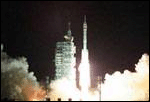|
China launched an unmanned spacecraft, "Shenzhou II",
early Wednesday
 |
|
China Launches Second Unmanned
Spacecraft
|
morning from Jiuquan Satellite Launching Center of Gansu Province,
and ten minutes after blast-off, the spaceship entered its preset
orbit.
The successful launch at Jiuquan Satellite Launch Center in northwestern
Gansu Province was China's second in a series of flights expected
to lead to a first manned space flight.
It marked a step forward in China's manned space program.
Chinese President Jiang Zemin sent a congratulatory message to
hail the successful launch and convey his greetings to the scientists,
cadres, workers, and People's Liberation Army servicemen involved
in the manufacture and launch of the unmanned spacecraft.
China conducted its first test flight of "Shenzhou" in
1999 at the Jiuquan launch site. And according to a plan, it will
launch more unmanned spacecraft until a manned spaceship takes shape.
"Shenzhou II" is composed of an orbital module, returning
module and booster rockets. Compared with its predecessor, the new
spacecraft has been improved in structure and technological qualities,
whose functions are basically identical to a manned space aircraft.
The spaceship, made solely by Chinese scientists and engineers,
is expected to return in a few days.
During the flight, experiments on space life sciences, space materials,
space astronomy and physics will be conducted.
The "Long March II F" carrier rocket that carries the
spacecraft was a new powerful product made in China especially for
the manned space program. Its overall structure, power system, control
system and remote monitoring system has been improved to ensure
reliability, and new trouble-shooting system and life-saving system
have been added for better safety of the spacemen.
This was the 65th launch of the "Long March" carrier
rocket series, and its 23rd successful launch in a row since October
1996.
The launch site was built solely by China, which was designed to
launch both satellites and space aircraft. It is capable of a general
assembly in a vertical way, vertical tests of the combined body
of the space aircraft and booster rockets and vertical transportation
of the combined body. The technology of long-distance monitoring
and control of the launching is also used.
The spacecraft was developed and manufactured mainly by the Chinese
Research Institute of Space Technology under the China Aerospace
Science and Technology Corporation, and Shanghai Research Institute
of Astronomical Technology. The carrier rocket was made by the China
Research Institute of Carrier Rocket Technology under the Aerospace
Corporation.
Relevant departments of the Chinese Academy of Sciences and the
Ministry of Information Industry took part in the design, manufacture
and test of the project.
During the flight, under the command of the Beijing Aerospace Directing
and Controlling Center, the Xi'an Satellite Monitoring Center of
China and the surveying ships named "Yuanwang" stationed
at high seas will trace, survey and control its operations.
An official responsible for the launch said that the success of
the "Shenzhou II" is "of great importance for China
to comprehensively grasp the manned space technologies and make
technological breakthroughs."
"More unmanned test flights will be launched to pave the way
for sending Chinese astronauts into space in the end," he said.
??People's Daily 01/10/01??
|










